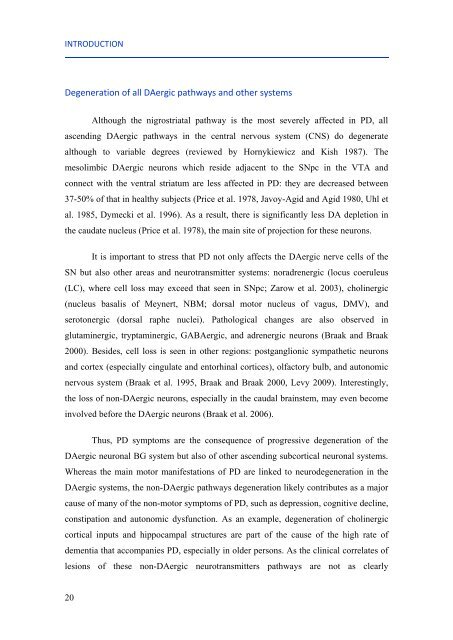Mechanisms of aluminium neurotoxicity in oxidative stress-induced ...
Mechanisms of aluminium neurotoxicity in oxidative stress-induced ...
Mechanisms of aluminium neurotoxicity in oxidative stress-induced ...
Create successful ePaper yourself
Turn your PDF publications into a flip-book with our unique Google optimized e-Paper software.
INTRODUCTION<br />
Degeneration <strong>of</strong> all DAergic pathways and other systems<br />
20<br />
Although the nigrostriatal pathway is the most severely affected <strong>in</strong> PD, all<br />
ascend<strong>in</strong>g DAergic pathways <strong>in</strong> the central nervous system (CNS) do degenerate<br />
although to variable degrees (reviewed by Hornykiewicz and Kish 1987). The<br />
mesolimbic DAergic neurons which reside adjacent to the SNpc <strong>in</strong> the VTA and<br />
connect with the ventral striatum are less affected <strong>in</strong> PD: they are decreased between<br />
37-50% <strong>of</strong> that <strong>in</strong> healthy subjects (Price et al. 1978, Javoy-Agid and Agid 1980, Uhl et<br />
al. 1985, Dymecki et al. 1996). As a result, there is significantly less DA depletion <strong>in</strong><br />
the caudate nucleus (Price et al. 1978), the ma<strong>in</strong> site <strong>of</strong> projection for these neurons.<br />
It is important to <strong>stress</strong> that PD not only affects the DAergic nerve cells <strong>of</strong> the<br />
SN but also other areas and neurotransmitter systems: noradrenergic (locus coeruleus<br />
(LC), where cell loss may exceed that seen <strong>in</strong> SNpc; Zarow et al. 2003), chol<strong>in</strong>ergic<br />
(nucleus basalis <strong>of</strong> Meynert, NBM; dorsal motor nucleus <strong>of</strong> vagus, DMV), and<br />
serotonergic (dorsal raphe nuclei). Pathological changes are also observed <strong>in</strong><br />
glutam<strong>in</strong>ergic, tryptam<strong>in</strong>ergic, GABAergic, and adrenergic neurons (Braak and Braak<br />
2000). Besides, cell loss is seen <strong>in</strong> other regions: postganglionic sympathetic neurons<br />
and cortex (especially c<strong>in</strong>gulate and entorh<strong>in</strong>al cortices), olfactory bulb, and autonomic<br />
nervous system (Braak et al. 1995, Braak and Braak 2000, Levy 2009). Interest<strong>in</strong>gly,<br />
the loss <strong>of</strong> non-DAergic neurons, especially <strong>in</strong> the caudal bra<strong>in</strong>stem, may even become<br />
<strong>in</strong>volved before the DAergic neurons (Braak et al. 2006).<br />
Thus, PD symptoms are the consequence <strong>of</strong> progressive degeneration <strong>of</strong> the<br />
DAergic neuronal BG system but also <strong>of</strong> other ascend<strong>in</strong>g subcortical neuronal systems.<br />
Whereas the ma<strong>in</strong> motor manifestations <strong>of</strong> PD are l<strong>in</strong>ked to neurodegeneration <strong>in</strong> the<br />
DAergic systems, the non-DAergic pathways degeneration likely contributes as a major<br />
cause <strong>of</strong> many <strong>of</strong> the non-motor symptoms <strong>of</strong> PD, such as depression, cognitive decl<strong>in</strong>e,<br />
constipation and autonomic dysfunction. As an example, degeneration <strong>of</strong> chol<strong>in</strong>ergic<br />
cortical <strong>in</strong>puts and hippocampal structures are part <strong>of</strong> the cause <strong>of</strong> the high rate <strong>of</strong><br />
dementia that accompanies PD, especially <strong>in</strong> older persons. As the cl<strong>in</strong>ical correlates <strong>of</strong><br />
lesions <strong>of</strong> these non-DAergic neurotransmitters pathways are not as clearly

















